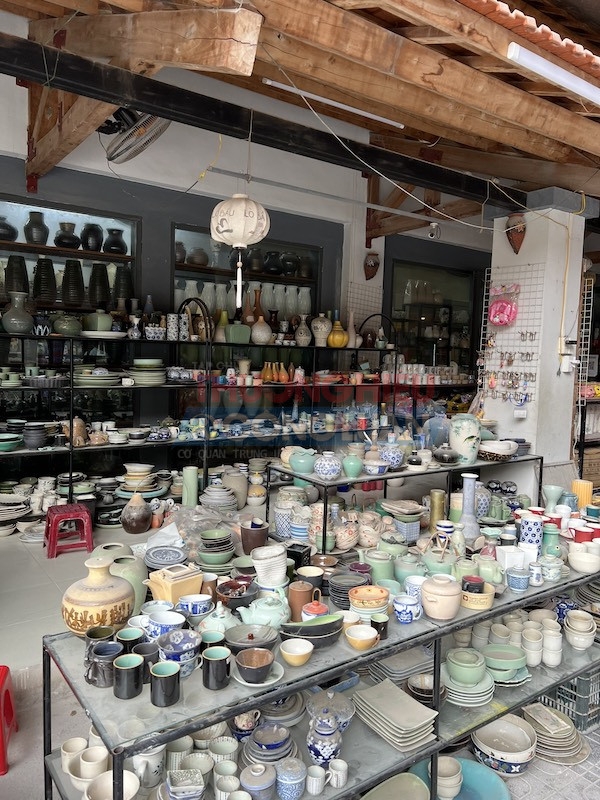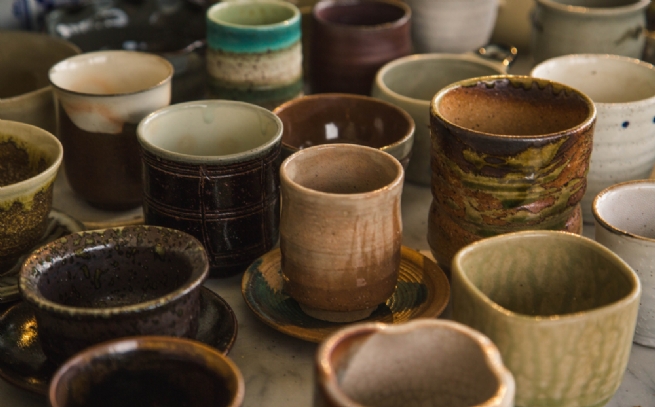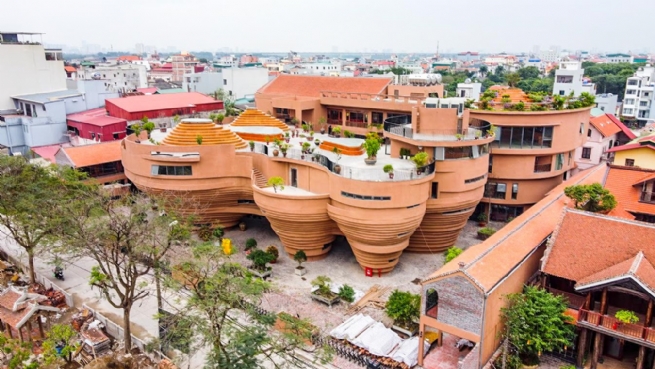2:00:20 PM | 8/10/2024
Bat Trang Pottery Village is located on the banks of the Red River, in Gia Lam District, on the outskirts of Hanoi. The name Bat Trang means “large yard”, and the village has a history dating back to the Le Dynasty. This is the most famous ancient pottery village in Vietnam, as well as a place that domestic and foreign tourists cannot help but visit at least once.

Despite the rapid changes of the capital, Bat Trang pottery village still retains its inherent nostalgic features, with walls dotted with green moss, bearing a yellow color that has been stained by time. In recent years, Bat Trang pottery village has become a “famous” tourist destination attracting a large number of domestic and foreign visitors. Perhaps, visitors from near and far are impressed and come here because of the unique nostalgic beauty of this village.
The living museum of the capital
Bat Trang Pottery Village is known for its long history, with famous ceramic artisans who have created exquisite products. According to historical records, the time of formation of Bat Trang pottery village is calculated around the 14th - 15th century. According to folk tales passed down, Bat Trang's history was formed before it was recorded in historical records because 3 royal students on their way to the Northern Song Dynasty learned pottery-making techniques from the local people and passed them on to the people in our country.
The genealogy of many families in Bat Trang also records the historical marks of the formation of Bat Trang craft village, the appearance of ceramic products in the lives of the people with different types of patterns, motifs, and glaze colors. This has also been confirmed by modern archaeologists through traces of layers of baked clay and ceramic pieces found in Thanh Hoa, Ninh Binh, etc.

The 15th - 17th centuries were the period of the strongest development in the history of the formation of Bat Trang pottery village and of the ceramic export industry of our country, in which Bat Trang played the most important role. Bat Trang had a great advantage in being located on the banks of the Red River between Thang Long citadel and Pho Hien, which was the gateway to trade with the outside world. Through merchant ships from China, Japan, Southeast Asian countries, and Western European countries, Vietnamese ceramics were brought to many other countries in the world.
By the 18th - 19th centuries, the Trinh Nguyen dynasty introduced policies to restrict foreign trade, causing trade relations between Vietnam and many other countries to decline severely, and ceramic products were no longer exported to the world market.
In the 60s of the 20th century, when the state was in the process of forming cooperatives, Bat Trang pottery village was also established with workers working here. They practiced and created in the pottery profession, thereby creating a generation of famous pottery craftsmen such as Dao Van Can, Nguyen Van Khieu, Le Van Van, Le Van Cam... When our country joined the market economy, the pottery village also had many changes. The cooperatives were dissolved, and replaced by companies specializing in this product, along with small-scale production households, creating a famous Bat Trang pottery village in our country. Thus, we can see that the history of the formation of Bat Trang craft village began hundreds of years ago. Through many historical events, different periods of prosperity and decline in each period, Bat Trang pottery village has always been steadfast, and proud to be the oldest and largest pottery craft village in our country. Nowadays, Bat Trang ceramic products are becoming more and more abundant and diverse. Besides traditional products, Bat Trang also produces many new products to meet domestic consumption needs such as teapots, bowls, plates, vases, etc., and export products according to orders. From here, Bat Trang ceramic products have also appeared in the markets of many European and Asian countries. Some artisans have succeeded in restoring traditional ceramic products with designs and glazes from the Ly, Tran, Le, and Mac dynasties…

The quintessence of traditional craft villages
Bat Trang ceramics are rich in types and designs, with 3 main lines: Household ceramics; Ceramics for worship; and Decorative items sold domestically and exported. In addition to traditional products, production facilities are constantly researching, learning, and designing many product models suitable for development trends and consumer tastes. Therefore, Bat Trang ceramic products not only dominate the domestic market but also gradually affirm their role and brand in the international market. During the process of making the product, people have created equipment, tools, and machines to support the process of making such as gas furnaces, soil mixers, compressors, molds, etc.
In its history of formation and development, Bat Trang has produced many unique products from ceramics, such as jade glaze, brown flowers, crackle glaze, blue flowers, etc. The characteristics of the glazes and decorative motifs have contributed to creating the famous brand of Bat Trang ceramic village. Through the ups and downs of history, from prosperity to decline, until now, Bat Trang ceramics still retain the unique and sophisticated beauty in each product, bringing Bat Trang ceramics to increasingly integrate and develop in the world market.
Bat Trang pottery is still practiced by the community and is increasingly developing, each household is an independent production unit. Technology and techniques in the production process are applied by the community to improve quality, quantity, time, labor, environmental issues...
Bat Trang pottery is the crystallization of human creativity through many generations. When making products, artisans, in addition to applying the techniques learned from their ancestors, also have to explore, learn, discover, and create new patterns, techniques, or designs to meet market demands. Pottery is one of the cultural identification characteristics, reflecting the cultural diversity of the community practicing pottery in Bat Trang village. In the same village, each artisan's products have their soul and characteristics. Bat Trang Pottery Village contributes to the transmission, preservation, and dissemination of cultural symbols and traditional glazes, which is the driving force for the development and promotion of the heritage value of previous generations. Bat Trang pottery products demonstrate the technical and aesthetic values of the craftsmen, creating diversity, richness, and uniqueness for the village's products. Bat Trang Pottery Village contributes significantly to increasing the value of local products, collecting budget for the state, creating jobs and contributing to raising income and living standards for people in the village and neighboring areas, improving social security indicators. Bat Trang pottery has built a large network of craftsmen, the Bat Trang Pottery Association, and beyond the scope of the village and commune; building economic relationships between practitioners to create cohesion and mutual support. With its outstanding value, Bat Trang pottery was included in the List of National Intangible Cultural Heritage by the Minister of Culture, Sports, and Tourism under Decision No. 4610/QD-BVHTTDL dated December 20, 2019. Bat Trang ceramic brand has affirmed its position and potential in the process of development and international integration. Now, Bat Trang ceramic is not only present throughout the country but also famous in foreign markets. Bat Trang products have been exported to Europe, America, Japan, Taiwan, Korea...

Transforming and integrating
The development of craft villages in general and Bat Trang craft village in particular, has contributed significantly to the economic growth rate, solving labor, employment as well as many other social issues for localities. However, in the context of integration and fierce competition not only domestically but also in foreign markets, Bat Trang Ceramic Craft Village is facing challenges to find a sustainable position for itself. Since 2002, Bat Trang artisans have linked up, produced, and consumed products through the Bat Trang Ceramic Association, so it is very convenient in the production and consumption of products, contributing to the development of local craft villages, and affirming the brand.
Bat Trang has 8,500 people but has more than 200 enterprises, and more than 1,000 families producing and trading ceramics, including 140 artisans and thousands of skilled workers. More than 80% of the villagers make a living from ceramic production. Bat Trang's ceramic craft not only creates jobs in the commune but also creates jobs for 4,000 - 5,000 regular workers from other places, with an average income of more than 70 million VND/person/year. According to statistics from Bat Trang Commune People's Committee, the annual revenue from ceramic craft is up to 2,000 billion VND. In recent years, Bat Trang ceramic craft village has become a "famous" tourist destination attracting a large number of domestic and foreign tourists to visit. According to Bat Trang Commune People's Committee, in addition to the traditional craft village, Bat Trang commune currently has 9 historical, cultural and architectural relics, 2 revolutionary resistance relics, 23 ancient houses, and 16 family temples - places that preserve many traditional cultural features of ancient Bat Trang. Mr. Pham Huy Khoi, Chairman of Bat Trang Commune People's Committee, said: "After being recognized as a tourist destination, the number of domestic and international visitors to Bat Trang doubled in the last months of 2019. In 2020, despite being affected by the COVID-19 epidemic, thanks to the synchronous implementation of epidemic prevention and control solutions, the number of visitors shopping and visiting the craft village increased again. On average, every day, especially on weekends, Bat Trang welcomes from 3,000 to 5,000 visitors to visit, shop and experience". According to Mr. Pham Huy Khoi, visitors to Bat Trang ancient village can learn about the craft village at traditional production facilities and listen to stories from tour guides who grew up in Bat Trang village. The most interesting thing when coming to Bat Trang is that visitors can directly watch artisans make sophisticated ceramic products or mold products themselves to their liking. One of the new features of Bat Trang tourist area is that visitors can visit and experience many interesting activities at the Center of Vietnamese Craft Village Essence. This is a new project with unique architecture, likened to the Bat Trang ceramic museum, and is becoming a tourist attraction that attracts many visitors.

Visiting Bat Trang ceramic village today, customers can clearly see the sensitivity of the potters, they have renewed themselves to integrate into modern life. Currently, products such as flower vases, and teapots... of Bat Trang are handcrafted with traditional glaze patterns such as white, purple blue, and primitive patterns, giving way to beautiful products with high artistry, rich in variety, and diverse in design.
Bat Trang becoming a tourist destination has and will contribute to promoting the interest and attracting investment from organizations, individuals and businesses in production and tourism activities of Bat Trang in a sustainable direction, both preserving and developing the values of traditional craft villages and protecting a green, clean and modern living environment.
Source: Vietnam Business Forum
The page in collaboration with Hanoi Rural Development Department